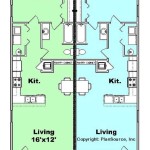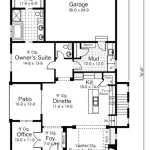How To Get The Floor Plans For My House
Obtaining floor plans for a house is a frequent requirement for homeowners undertaking renovation projects, insurance claims, or simply seeking a better understanding of their property's structure. The process of acquiring these plans can vary depending on the age of the house, its location, and whether previous owners retained copies. This article will explore various methods for securing floor plans, outlining the advantages and disadvantages of each approach.
Consulting Existing Documentation and Records
The first step in the search for house floor plans should involve a thorough examination of any existing documentation related to the property. Often, these documents are already in the homeowner’s possession, offering the quickest and most cost-effective route to obtaining the desired information.
Original Purchase Documents: When a house is initially purchased, a set of documents is typically provided to the buyer. These documents may include a survey, which can sometimes contain a basic floor plan. While these plans may not be highly detailed, they can provide a general overview of the layout, room dimensions, and structural elements.
Mortgage or Loan Documents: Similar to purchase documents, mortgage or loan applications may have required the submission of floor plans as part of the appraisal process. Banks and lending institutions often retain copies of these documents, which could be accessible upon request. It's important to note there might be legal limitations on accessing documents based on privacy laws.
Home Improvement Permits: If previous owners undertook any significant renovations or additions, they would have likely obtained permits from the local building department. These permits often require the submission of detailed floor plans that illustrate the proposed changes. Accessing these records can provide valuable insights into the house's evolution over time and the location of key structural components.
Insurance Policies: In some cases, insurance policies may contain floor plans, particularly if the policy covers structural damage. These plans are generally used for assessing risk and calculating premiums. Contacting the insurance provider to request a copy of the policy's related documentation could yield positive results.
Previous Owner Contact: If possible, contacting the previous owners of the house can be a fruitful endeavor. They may have retained copies of the original floor plans or any subsequent renovation plans. This approach relies on the previous owners' willingness to share the information and their ability to locate the documents.
When searching through these documents, it is crucial to organize the findings chronologically. This organization allows identifying any changes or additions made to the house over time, leading to a more complete understanding of its current layout.
Searching Public Records and Government Agencies
If existing documentation proves insufficient, the next step involves searching public records and contacting government agencies. Many municipalities and counties maintain records of building permits, property surveys, and other documents that may contain floor plans.
Local Building Department: The local building department is a primary source for obtaining house floor plans. These departments typically maintain records of all building permits issued for properties within their jurisdiction. Requesting access to these records can provide detailed floor plans that were submitted as part of the permit application process. It is essential to contact the building department directly to inquire about their procedures for accessing public records and any associated fees.
City or County Planning Department: The city or county planning department may also maintain records related to property development and zoning regulations. These records may include site plans, which can sometimes depict the layout of buildings on the property. While site plans may not provide the same level of detail as floor plans, they can offer valuable insights into the overall configuration of the house and its relationship to the surrounding landscape.
Tax Assessor's Office: The tax assessor's office is responsible for assessing the value of properties for tax purposes. As part of this process, they may have collected information about the size and layout of buildings. While they might not have detailed floor plans, they could possess sketches or diagrams that provide a general overview of the house's dimensions and room configurations.
Land Registry or Recorder's Office: The land registry or recorder's office maintains records of property ownership and transfers. These records may include surveys or plats that depict the boundaries of the property and the location of buildings. While these documents typically focus on the external features of the property, they can sometimes provide additional information about the house's layout.
When searching public records, it is crucial to have accurate information about the property, such as its address, legal description, and parcel number. This information will help the relevant agencies locate the correct records and expedite the search process. Keep in mind that public records may be subject to access restrictions, and there may be fees associated with obtaining copies of documents.
The availability of public records online varies significantly depending on the jurisdiction. Some municipalities have digitized their records and made them accessible through online portals, while others require in-person visits to review physical documents.
Creating New Floor Plans
If existing records and public sources fail to provide the necessary floor plans, the final option is to create them. This option can be achieved through professional surveying and architectural services or through self-measurement and drafting techniques.
Hiring a Professional Surveyor or Architect: Hiring a professional surveyor or architect is the most accurate and reliable way to obtain floor plans for a house. These professionals have the expertise and equipment necessary to measure the house accurately and create detailed floor plans that meet specific requirements. This methodology guarantees a precise representation of the property's layout, which is crucial for renovations and legal purposes.
Surveyor: A land surveyor can create a site plan that accurately depicts the boundaries of the property and the location of the house. While a surveyor may not provide detailed interior floor plans, they can provide an accurate foundation plan that is essential for architectural design. Surveyors use specialized equipment, such as total stations and GPS devices, to ensure accurate measurements.
Architect: An architect can create comprehensive floor plans that include detailed information about room dimensions, wall locations, door and window placements, and structural elements. Architects can also incorporate specific design requirements into the floor plans and provide renderings of the proposed renovations or additions.
Self-Measurement and Drafting: While less accurate than hiring a professional, self-measurement and drafting can be a viable option for creating basic floor plans. This approach involves carefully measuring the house's interior and exterior dimensions and using drafting tools or software to create a scaled drawing of the layout. This method is less costly, but requires attention to detail and an understanding of drafting principles.
Measurement Techniques: Begin by measuring the longest dimensions of the house, both inside and outside. Then, measure each room individually, paying close attention to the location of doors, windows, and other features. Use a laser measure for increased accuracy, particularly for longer distances. It's best practice to measure each dimension at least twice to minimize errors.
Drafting Tools and Software: Once the measurements are complete, use drafting tools or software to create a scaled drawing of the floor plan. Simple drafting tools, such as rulers, protractors, and graph paper, can be used for hand-drawn plans. Alternatively, various software programs, such as AutoCAD, SketchUp, or online floor plan creators, can be used to create digital plans. These software programs allow for precise measurements, layering, and the incorporation of additional details. Most of the software programs offer a free trial as well.
Accuracy Considerations: When creating floor plans through self-measurement and drafting, it is crucial to be aware of the potential for errors. Inaccuracies in measurements can lead to discrepancies in the floor plan, which can affect the accuracy of renovation plans or other projects. It is always advisable to double-check measurements and consult with a professional if necessary.
Whether hiring a professional or creating floor plans independently, clearly defining the purpose and scope of the plan is essential. This definition will guide the level of detail required and the methods used to create the plans.
Regardless of which method is employed, the obtained floor plans become a valuable asset for homeowners. They provide a comprehensive understanding of the house's structure and layout, facilitating informed decisions about renovations, insurance, and other property-related matters. Always ensure that the final product meets any necessary regulatory standards and building codes, particularly when undertaking significant alterations to the property.

Where You Can Buy House Plans Live Home 3d

9 Ways To Find Floor Plans Of An Existing House Blueprints Archid

House Plans How To Design Your Home Plan

House Plans How To Design Your Home Plan

Floor Plan Creator And Designer Free Easy App

Floor Plan Creator And Designer Free Easy App

How To Read A Floor Plan With Dimensions Houseplans Blog Com

Make Your Own Blueprint How To Draw Floor Plans

Make Your Own Blueprint How To Draw Floor Plans

How To Read A Floor Plan With Dimensions Houseplans Blog Com
Related Posts








